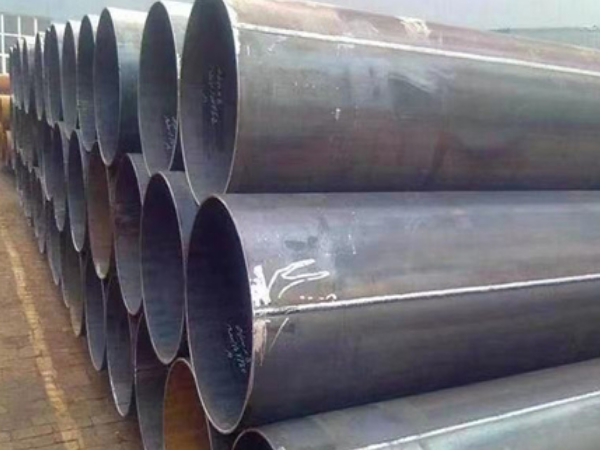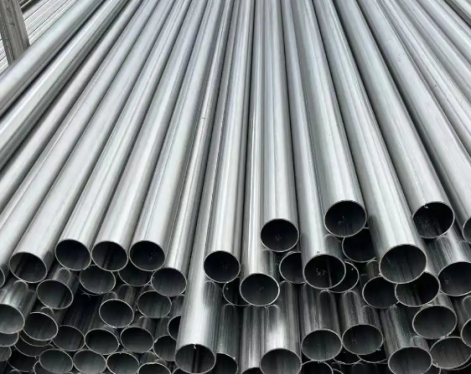Welded steel tube weld pores not only affect the tightness of the pipeline weld and cause pipeline leakage, but also become the induction point of corrosion, which seriously reduces the strength and toughness of the weld.
The factors that cause porosity in the weld are: moisture, dirt, oxide scale and iron filings in the flux, welding components and covering thickness, surface quality of the steel plate, treatment of the edge of the steel plate, welding process and steel tube forming process.
Measures to prevent porosity in welded steel tubes:
1) Flux composition: When the welded steel tube contains an appropriate amount of CaF2 and SiO2, it will react and absorb a large amount of H2 to generate HF with high stability and insoluble in liquid metal, which can prevent the formation of hydrogen pores.

2) The accumulation thickness of the flux is generally 25-45mm. The maximum value of the accumulation thickness of the flux with large particle size and small density, and the minimum value otherwise; the maximum value of the accumulation thickness of high current and low welding speed, and the minimum value otherwise. In addition, in summer or when the air humidity is high, the recovered flux should be dried before use.
3) Surface treatment of steel plate: In order to avoid sundries such as oxide scale falling off from uncoiling and leveling from entering the forming process, a plate surface cleaning device should be installed.
4) Steel plate edge treatment: rust and burr removal devices should be installed at the edge of the steel plate to reduce the possibility of pores. The position of the removal device is best installed after the edge milling machine and the disc shear. The structure of the device is two active wire wheels with adjustable gaps at the upper and lower positions on one side, which press the edge of the plate up and down.
5) Weld profile: the forming coefficient of the weld is too small, the shape of the weld is narrow and deep, the gas and inclusions are not easy to emerge, and it is easy to form pores and slag inclusions. Generally, the welding seam forming coefficient is controlled at 1.3-1.5, the maximum value for thick-walled welded tubes, and the minimum value for thin-walled tubes.
6) Reduce the secondary magnetic field: In order to reduce the influence of magnetic bias blowing, the connection position of the welding cable on the workpiece should be close to the welding terminal, so as to avoid the secondary magnetic field generated by some welding cables on the workpiece.
7) In terms of technology: the welding speed should be appropriately reduced or the current should be increased, so as to delay the crystallization speed of the weld pool metal, so as to facilitate the escape of gas; at the same time, if the delivery position of the strip is unstable, it should be adjusted in time to prevent frequent passes. Fine-tuning the front or rear axle maintains shape, making it difficult for gas to escape.
Welded steel tube refers to a steel pipe made of steel plate or strip steel after being crimped and welded, generally with a fixed length of 6 meters. The production process is simple, the production efficiency is high, the cost is low, and the development is fast, but the strength is generally lower than that of seamless steel pipes.
Go here if you want to know more about "Methods of extending the service life of welded pipes"
The factors that cause porosity in the weld are: moisture, dirt, oxide scale and iron filings in the flux, welding components and covering thickness, surface quality of the steel plate, treatment of the edge of the steel plate, welding process and steel tube forming process.
Measures to prevent porosity in welded steel tubes:
1) Flux composition: When the welded steel tube contains an appropriate amount of CaF2 and SiO2, it will react and absorb a large amount of H2 to generate HF with high stability and insoluble in liquid metal, which can prevent the formation of hydrogen pores.

2) The accumulation thickness of the flux is generally 25-45mm. The maximum value of the accumulation thickness of the flux with large particle size and small density, and the minimum value otherwise; the maximum value of the accumulation thickness of high current and low welding speed, and the minimum value otherwise. In addition, in summer or when the air humidity is high, the recovered flux should be dried before use.
3) Surface treatment of steel plate: In order to avoid sundries such as oxide scale falling off from uncoiling and leveling from entering the forming process, a plate surface cleaning device should be installed.
4) Steel plate edge treatment: rust and burr removal devices should be installed at the edge of the steel plate to reduce the possibility of pores. The position of the removal device is best installed after the edge milling machine and the disc shear. The structure of the device is two active wire wheels with adjustable gaps at the upper and lower positions on one side, which press the edge of the plate up and down.
5) Weld profile: the forming coefficient of the weld is too small, the shape of the weld is narrow and deep, the gas and inclusions are not easy to emerge, and it is easy to form pores and slag inclusions. Generally, the welding seam forming coefficient is controlled at 1.3-1.5, the maximum value for thick-walled welded tubes, and the minimum value for thin-walled tubes.
6) Reduce the secondary magnetic field: In order to reduce the influence of magnetic bias blowing, the connection position of the welding cable on the workpiece should be close to the welding terminal, so as to avoid the secondary magnetic field generated by some welding cables on the workpiece.
7) In terms of technology: the welding speed should be appropriately reduced or the current should be increased, so as to delay the crystallization speed of the weld pool metal, so as to facilitate the escape of gas; at the same time, if the delivery position of the strip is unstable, it should be adjusted in time to prevent frequent passes. Fine-tuning the front or rear axle maintains shape, making it difficult for gas to escape.
Welded steel tube refers to a steel pipe made of steel plate or strip steel after being crimped and welded, generally with a fixed length of 6 meters. The production process is simple, the production efficiency is high, the cost is low, and the development is fast, but the strength is generally lower than that of seamless steel pipes.
Go here if you want to know more about "Methods of extending the service life of welded pipes"









